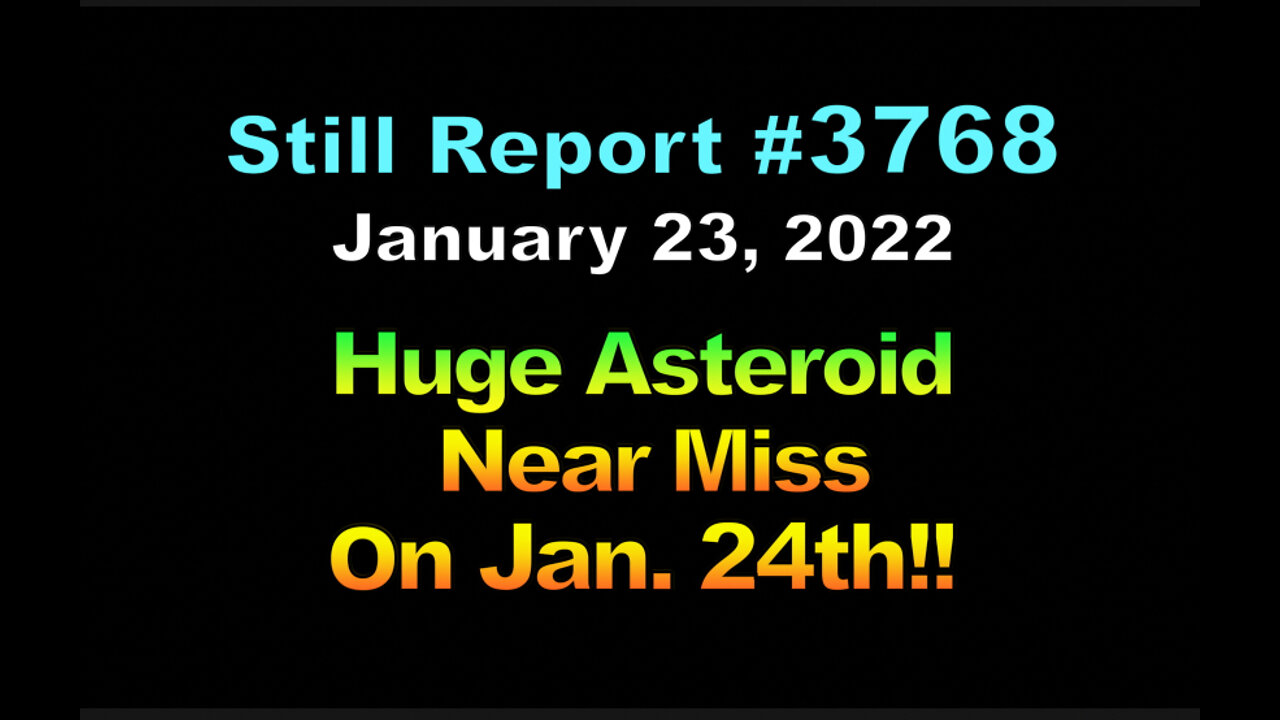Premium Only Content

Huge Asteroid Near Miss, Jan. 24th!!, 3768
Good afternoon, I’m still reporting on planetary destruction.
On Monday, Jan. 24th, at 16:51 EST (-5), planet earth will see a chunk of rock the size of the Washington Monument whiz safely by, unnoticed for all but a handful of scientific and military observers, according to NASA’s asteroid tracker.
Known as 2017 XC62, the asteroid is estimated to be between 84 meters and 190 meters in size and is set to fly past the Earth on January 24 at a speed of nearly 47,344 miles per hour. However, it will not actually impact Earth, coming no closer than 1.2 million miles – about 5 times the distance to the moon.
Just 5 days ago, on Jan. 18, an even bigger asteroid – one about 1,000 meters in diameter – passed earth without incident as well, so this is not uncommon. Twenty-eight years ago, NASA set up a Planetary Defense Coordination Office to study the threat and offer solutions. Since then, it has catalogued over 15,000 asteroids of this size, but none of them is projected to hit the earth for at least another 100 years. However, scientists also believe that there could be many more out there which blast into our solar system unannounced from highly elliptical orbits. These represent a real threat.
So, on Nov. 24, 2021, NASA launched the first satellite to test whether a kinetic impact could sufficiently alter the orbit of an asteroid. This scheduled impact on Sept. 26 of this year.
The project is called DART for Double Asteroid Redirection Test. The targeted asteroid in question is actually a double asteroid. The larger one is nearly a half-mile in diameter, but the smaller one is only one-tenth that size – about 525 feet.
The DART spacecraft will impact the smaller one dead center, from behind its orbital path, thereby speeding up it’s orbit around the larger one by several minutes. Scientists will track the change precisely to determine the effect on the asteroid’s trajectory.
Why is this important. Although NASA has catalogued 15,000 asteroids of 1,000 meters – 3,000 feet – in diameter. There are thousands of smaller ones.
How big would an asteroid impact be to produce significant damage? A lot smaller than the one flying by tomorrow. Most meteors smaller than a car – 15-feet in diameter – will burn up in the atmosphere harmlessly. It’s estimated that a meteor the size of a house – about 50-feet in diameter – about 60 times smaller than those catalogued by NASA - is about the size of a meteor which, in 1908, exploded above the Podkamennaya Tunguska River in Russia, in what has now become known as the Tunguska Event.
It produced a massive 12 megaton explosion, causing widespread destruction for thousands of kilometers. That would make it about 800 times more powerful than "Little Boy," the first atomic bomb detonated during World War II over Hiroshima.
The death toll from the Tunguska event was extremely low, however, with only around three people thought to have been killed in it, due to how remote and sparsely populated the region was. But the damage was still evident, with about 80 million trees completely flattened by winds of around 44,000 miles per hour. Tremors and airwaves were even felt as far away as Washington State and Indonesia. The few eyewitness accounts that do exist recounted the terrifying explosion, strong winds, and tremors.
And this is the point of this article, to highlight the deadly importance of this NASA mission.
This account from the Jerusalem Post, of Jan. 15, 2022
"The sky split in two and fire appeared high and wide over the forest," recounted a man who was about 65 kilometers south of the explosion.
"The split in the sky grew larger, and the entire northern side was covered with fire," he said. "At that moment I became so hot that I couldn't bear it as if my shirt was on fire; from the northern side, where the fire was, came strong heat. I wanted to tear off my shirt and throw it down, but then the sky shut closed, and a strong thump sounded, and I was thrown a few meters. I lost my senses for a moment, but then my wife ran out and led me to the house.
"After that such noise came, as if rocks were falling or cannons were firing; the Earth shook, and when I was on the ground, I pressed my head down, fearing rocks would smash it," he said. "When the sky opened up, hot wind raced between the houses, like from cannons, which left traces in the ground like pathways, and it damaged some crops. Later we saw that many windows were shattered, and in the barn, a part of the iron lock snapped."
The Tunguska event is the largest in recorded history – though larger prehistoric ones happened. A prehistoric meteor strike of an asteroid of perhaps of 1,000 meters hitting on the Yucatan Peninsula of what is now Mexico was believed to be the global catastrophic event that killed off the dinosaurs, by submerging the planet in a blanket of clouds so thick as to last for years and killing most edible plant life. Could it have also been the Noah’s Ark event as described in the Bible?
I’m still reporting from the citadel of world freedom. Good day.
-
 2:03
2:03
The Still Report
6 days agoWill Voters Reject Newsom's Risky Vote Scheme? | #4805
6851 -
 0:39
0:39
Mfharger
4 years agoNear miss Musky
32 -
 0:52
0:52
KMGH
3 years agoLook up! Asteroid passing earth
25 -
 1:18
1:18
The Dashboard
3 years agoNear Miss with Wrong Way Driver
32 -
 0:32
0:32
AquaDawg
3 years ago $0.04 earned2021 - Curly has a near miss!
95 -
 DVR
DVR
TheCrucible
1 hour agoThe Extravaganza! EP: 31 (9/03/25
28.8K -
 LIVE
LIVE
Wayne Allyn Root | WAR Zone
5 hours agoWAR Zone LIVE | 3 SEPTEMBER 2025
75 watching -
 1:28:57
1:28:57
Redacted News
2 hours agoBREAKING! Putin's DEVASTATING news for Europe | Secret UFO Space Base in Huntsville | Redacted Live
63.4K74 -
 1:17:49
1:17:49
vivafrei
5 hours agoEpstein Press Conference DEBACLE! Missing Minute FOUND? Canada Continues to Fall! & MORE!
74.7K56 -
 29:30
29:30
Stephen Gardner
2 hours ago🟢YES! Trump’s Doing It! Ben Shapiro UNLEASHES on Democrat STUPIDITY!
19.5K14